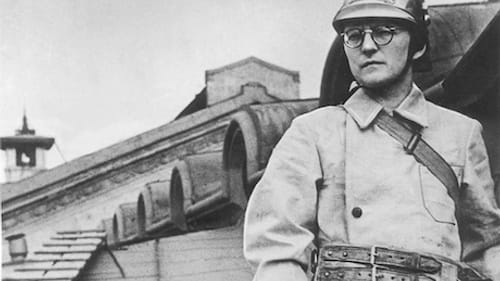Stay in the Loop
BSR publishes on a weekly schedule, with an email newsletter every Wednesday and Thursday morning. There’s no paywall, and subscribing is always free.
An ambiguous reflection on war
Philadelphia Orchestra presents 'Joshua Bell and Yannick'

What proof do you need that music can capture and express all the extremes of human emotion? You can start with the Philadelphia Orchestra’s performance last weekend of works by Wieniawski and Shostakovich. Yannick Nézet-Séguin was born to conduct Shostakovich’s gritty Symphony No. 7, the “Leningrad,” on the second part of the program, while guest soloist, Joshua Bell, opened the concert with spellbinding lyricism in Wieniawski’s Violin Concerto No. 2.
"Little bit of the punk"
Bell is one of the most popular classical musicians of our time, and for good reason. Although, incredibly, he is 50, the Indiana-born violinist still has the kind of youthful charisma that lights up the hall as he walks onstage.
There is a little bit of the punk about him, too, a tiny chip on his shoulder he dares you to push off. This delightful blend of mixed messages filters through a lifetime of training and his own innate understanding of the music he plays. It’s an unbeatable combination.
This combination flamed during Friday’s matinee as Bell went far beyond the superficial virtuosic snares of this lush concerto. He brought a single voice of cohesion, intense feeling, and unified expression to one of the most engaging works of the Romantic repertoire.
The soloist and orchestra played as true partners, one never dominating the other, as Nézet-Séguin balanced the musicians to support and converse with Bell. Off to a relaxed start, the orchestra picked up fervor by the second half of the first movement, without detracting from the heartfelt melodies flowing from the soloist's Stradivarius.
Bell was almost unsurpassable in the bright upper register of his instrument, less so with the lower tones of the concerto’s early sections. This was more than rectified in the second and third movements with some lovely segues into the violin’s darker, more mysterious side. He unveiled the gamut of human feeling hidden in this concerto, with gypsy-like airs, lilting rhythms, and a reflective lyricism that uncovered real depths below a sparkling surface.
Hard work, harder subject
After intermission, Nézet-Séguin led a performance of the “Leningrad.” I wonder if we would listen differently to this at once disturbing and enlightening work were it called the “St. Petersburg.” After all, the city is now associated with aesthetics and charm.
Of course, the city where Shostakovich lived, studied, and composed was renamed Leningrad in honor of the Communist icon when this work was composed in 1941. The story of the symphony’s composition is almost as riveting as the work itself. Shostakovich kept composing even as Hitler’s troops invaded his city, forcing him to relocate in musical midstream.

What a taxing symphony to conduct! It is not only an hour and 15 minutes long, but requires continuous vigilance and meticulous timing to bring out colors and dynamic variety. With its snare drums and muted trumpets, the work could easily sound sinisterly jocular, like a Stravinsky circus, or even cheesy, with the heavy-handed march of boots on the ground.
It’s also cloaked in extramusical ambiguity, since Shostakovich agreed to undertake this project about an invasion of Leningrad well before the actual 1941 Nazi invasion. Many scholars today believe the totalitarian Communist Party regime is actually under attack in the piece. Perhaps oppression in general provides the backstory for this thought-provoking work.
Question everything
Despite its grim theme, the symphony is shot through with energy, from the first movement’s relentless development of its Bolero-like invasion theme, to its stirring finale with double cymbals and brass choir. In between, a funerary section of the first movement recalls Beethoven’s Eroica (as does the four-note victory motif from Beethoven’s Fifth, quoted near the end), while memorable hymn-like fragments whisper a gentle call for healing and peace.
The orchestra and Nézet-Séguin, always a lively figure on the podium, never flagged in this performance, capturing the variety of Shostakovich’s ideas as well as the unity of his artistic vision. Does the requiem commemorate the half-million Soviet civilians who died at the hands of the Nazis, or is it, archetypically, the death of fascism? Is the victory that some suppose is commemorated in the final movement even possible?
We may never know the answers to these questions, and even more important questions are yet to be asked. Like all great artists, Shostakovich opens the door to speculation and lets us judge.
What, When, Where
Joshua Bell and Yannick. Violin Concerto No. 2 in D minor, Op. 22, by Henryk Wieniawski; Symphony No. 7 in C major, Op. 60, by Dmitri Shostakovich. Joshua Bell, violin; conducted by Yannick Nézet-Séguin. February 15-18, 2018, at the Kimmel Center's Verizon Hall, 300 S. Broad Street, Philadelphia. (215) 893-1999 or philorch.org.
Sign up for our newsletter
All of the week's new articles, all in one place. Sign up for the free weekly BSR newsletters, and don't miss a conversation.
 Linda Holt
Linda Holt